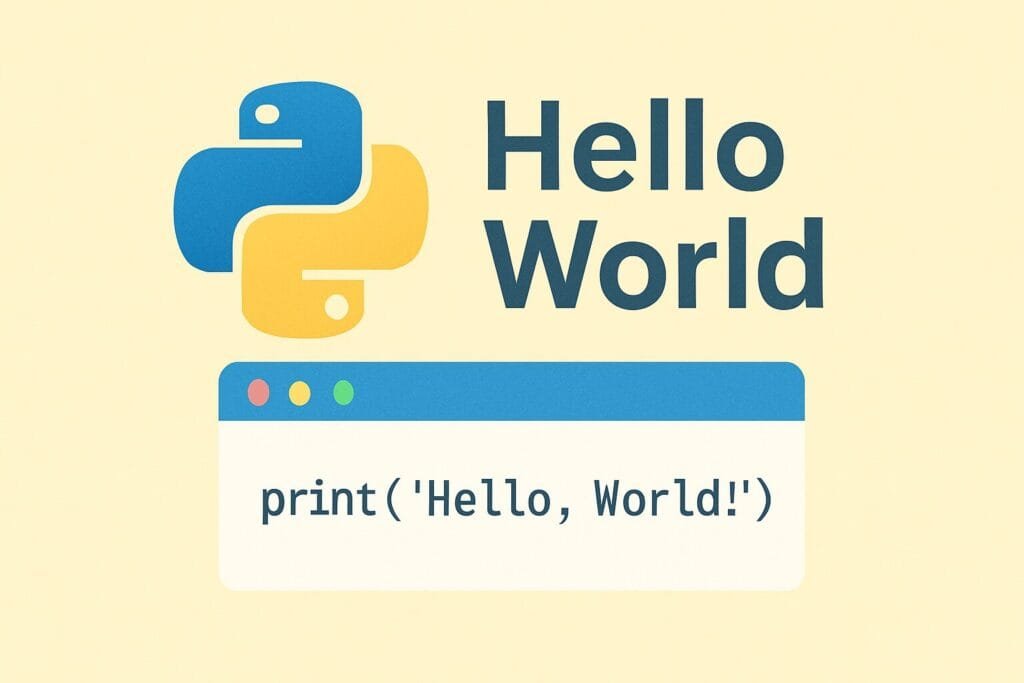Learning Python is one of the best decisions you can make as a beginner programmer. Python is simple, versatile, and widely used in web development, data science, artificial intelligence, and automation. Every programming journey usually starts with the same simple program: Hello World. In this article, we will guide you step-by-step to write your first Python program and understand what happens behind the scenes.
What Is the Hello World Program?
The Hello World program is traditionally the first program that beginners learn in any programming language. Its purpose is simple: display the phrase “Hello, World!” on the screen. This program helps you understand the basic structure of a programming language, test if your environment is set up correctly, and gives you your first successful coding experience.

Why Python Is Great for Beginners
- Easy to Read: Python code looks like plain English.
- Cross-platform: It runs on Windows, macOS, and Linux without major issues.
- Large Community: Millions of developers are available to help through tutorials and forums.
- Popular Applications: Used in AI, machine learning, automation, and more.
Setting Up Your Python Environment
Before writing the program, you need to install Python on your computer. Follow these steps:
- Download Python from the official website: python.org.
- Install Python by following the installation wizard. Make sure you check Add Python to PATH during installation.
- Verify the installation by opening your terminal (Command Prompt or PowerShell on Windows, or Terminal on macOS/Linux) and typing:
python --version
If installed correctly, you will see something like:
Python 3.12.0
Writing Your First Hello World Program
Now let’s write the actual program. Open your favorite text editor (Notepad, VS Code, PyCharm, or Sublime Text) and type the following code:
print("Hello, World!")
Save the file as hello.py. Next, run the program using the terminal:
python hello.py
If everything is correct, the output will be:
Hello, World!
Understanding the Code
Let’s break down the one line of code:
print()is a built-in Python function that outputs text to the screen.- The text inside the quotation marks
"Hello, World!"is a string. Strings in Python are sequences of characters wrapped in quotes.
This may look too simple, but it is the foundation of every Python program. Almost all complex Python projects build upon this principle of outputting and manipulating data.
Adding More Examples
Let’s expand the Hello World program with a few practical variations:
1. Personalized Greeting
name = "Alice"
print("Hello, " + name + "!")
Output:
Hello, Alice!
2. Asking User Input
name = input("What is your name? ")
print("Hello, " + name + "!")
When you run this program, it will ask for your name and greet you personally.
3. Multiple Lines of Output
print("Hello, World!")
print("Welcome to Python programming.")
print("This is your first step into coding.")
Common Errors and Fixes
When writing your first program, you may encounter some errors. Here are common mistakes and solutions:
| Error | Cause | Solution |
|---|---|---|
SyntaxError: EOL while scanning string literal | Missing closing quotation mark. | Ensure your string has both opening and closing quotes. |
ModuleNotFoundError | You may have typed pythin instead of python. | Double-check the command. |
| No output | Forgot to save the file or run it with the wrong command. | Save your file as .py and use python hello.py. |
Next Steps After Hello World
Once you successfully run your Hello World program, you are ready to explore more. Here are recommended next steps:
- Learn about variables and data types in Python.
- Explore loops (for and while) to repeat actions.
- Understand conditional statements like
if,else, andelif. - Try solving small beginner projects such as a calculator, number guessing game, or to-do list.
Conclusion
Writing your first Python program, the classic Hello World, is a milestone every programmer remembers. It is the beginning of your coding journey, showing how a single line of code can produce visible results. From here, you can dive deeper into Python and start building powerful applications.
For more learning resources, check out the official Python documentation: Python Docs.

